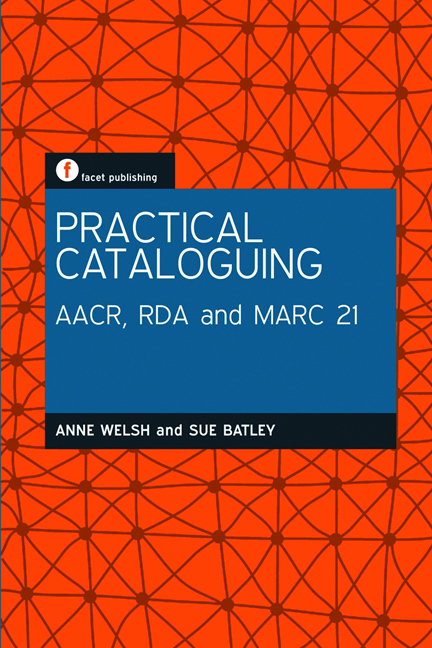Book contents
- Frontmatter
- Dedication
- Contents
- Acknowledgements
- Preface
- 1 Catalogues and cataloguing standards
- 2 The FRBRization of the catalogue
- 3 Bibliographic elements
- 4 Access points and headings
- 5 RDA: resource description and access
- 6 AACR and RDA
- 7 MARC 21
- 8 Practical cataloguing: bringing it all together
- 9 The birth of RDA and the death of MARC?
- 10 Examples
- References
- Index
2 - The FRBRization of the catalogue
Published online by Cambridge University Press: 08 June 2018
- Frontmatter
- Dedication
- Contents
- Acknowledgements
- Preface
- 1 Catalogues and cataloguing standards
- 2 The FRBRization of the catalogue
- 3 Bibliographic elements
- 4 Access points and headings
- 5 RDA: resource description and access
- 6 AACR and RDA
- 7 MARC 21
- 8 Practical cataloguing: bringing it all together
- 9 The birth of RDA and the death of MARC?
- 10 Examples
- References
- Index
Summary
Functional Requirements for Bibliographic Records (FRBR) was first published in 1998 (IFLA, 1998) and, as the commentator William Denton has pointed out, ‘is an end point of almost 175 years of thinking about what catalogs are for and how they should work – an end point, not the end point’ (Denton, 2007).
While carrying on the tradition of the supremacy of the user's convenience established by Cutter, FRBR is concerned with the intellectual concept of the work – the concept of the book (or video or piece of music) – and its relationship to the copies that are held by individual libraries.
The word ‘work’ has been used throughout the history of cataloguing with more or less specificity. Panizzi, the most famous of the keepers of the British Museum Library, was concerned with the relationships between different versions of books, asserting that ‘a reader may know the work he requires; but he cannot be expected to know all the peculiarities of different editions, and this information he has a right to expect from the catalogues’ (Lubetzky and Svenonius, 2001).
Indeed, such questions have been central to much enumerative and analytical bibliography over the years, with academics and rare books librarians documenting not only editions but also impressions and states of early printed books (Gaskell, 1995) and provenance information at the individual copy level of rare materials (Pearson, 1998).
In making the convenience of the user its first principle, FRBR goes on to consider how the user's needs might best be served. As Barbara Tillett has put it, ‘Especially important are the efforts libraries make to help users find resources by uniquely identifying the resources through bibliographic description and by collocating or gathering together resources that share some common characteristic. These are usually resources in a library's own collections, but sometimes bibliographic descriptions or pointers are provided to resources beyond its collections’ (Tillett, 2007).
Relationships at the heart of the catalogue
FRBR suggests that the library catalogue should do more than enable the location of a particular item. In essence, in creating a ‘FRBRized’ catalogue record, we are describing not only the thing we have in our hands, but its relationship to other things in the bibliographic universe – not only to its creator(s) and previous editions, but, theoretically, to any other thing that may be of use to an end user.
- Type
- Chapter
- Information
- Practical CataloguingAACR, RDA and MARC 21, pp. 7 - 16Publisher: FacetPrint publication year: 2012

